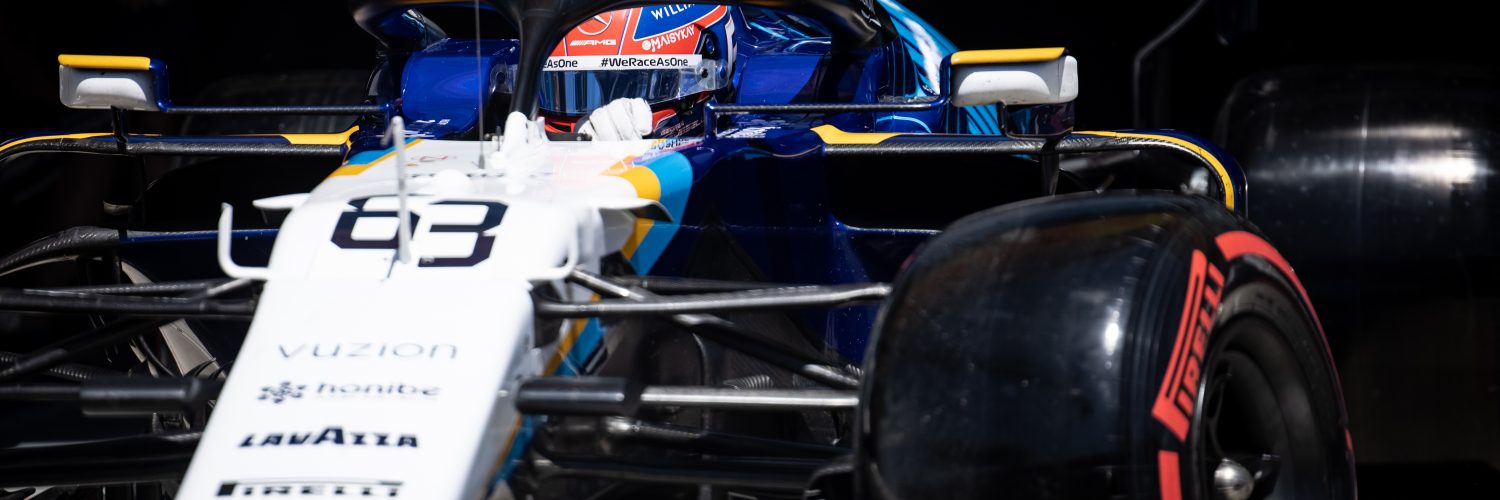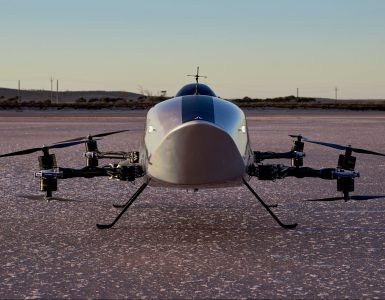A ‘Mission Impossible’ it may seem, but Williams have trodden the path between improving the underlying pace of the 2020 spec FW43 and preparing for 2022 within the underlying resource restrictions. As the season restarts after the summer shutdown, the car has consistently qualified out of the Q1 group and in the races before the shutdown George Russell had taken the car into Q3 on merit.
Where luck is preparation met with opportunity, the team also gain two pairs of points finishes culminating in a ‘podium’ for Russell at Spa, as a result of the rain hindered ‘race’ and a qualifying run in the rain netting an incredible P2.
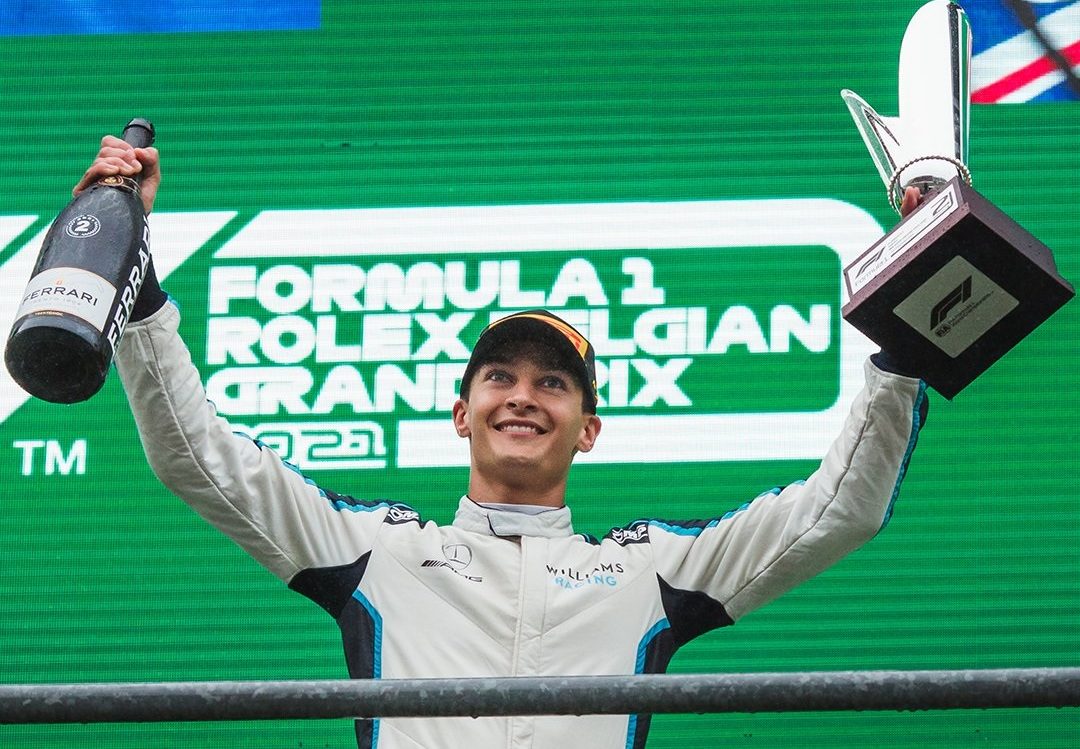 Williams, the ever-resourceful engineering operation, came out with the revised FW43B at the start of 2021, an updated version of the 2020 car as demanded by the regulations. While optimistic the results of the “B” spec car have gone way beyond expectations, driven partly by circumstances, virtuoso driving and some canny development work from a newly managed technical department.
Williams, the ever-resourceful engineering operation, came out with the revised FW43B at the start of 2021, an updated version of the 2020 car as demanded by the regulations. While optimistic the results of the “B” spec car have gone way beyond expectations, driven partly by circumstances, virtuoso driving and some canny development work from a newly managed technical department.
After a difficult season through the pandemic in 2020, for every team the transition from 2020 to 2021 was equally difficult. There were rule changes, a technical development freeze and the introduction of a budget cap. For a team starting its climb back to competitiveness this was an obstacle, but in hindsight may prove to be an opportunity for the Williams team, given the restructuring and looming 2022 regulations.
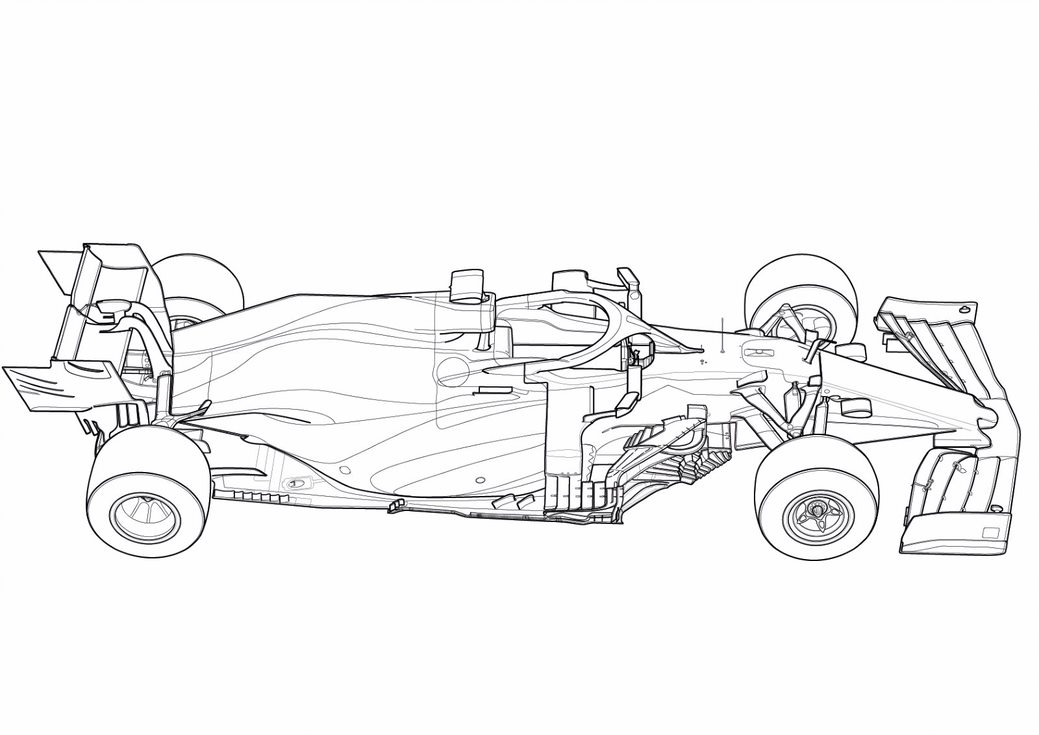
Management
Even before the car turned a wheel, Williams had been working on another technical side of the team – the management. Signed late in 2020 and joining the team in February, Jost Capito joined as the team’s CEO. A natural engineer, Capito has experience in BMW, Sauber, Ford, VW and latterly McLaren. Straight away he started building the technical management at Grove, with Francois Xavier De Maison joining from VW, along with Willi Rampf. Known as FX, De Maison becomes Technical Director.
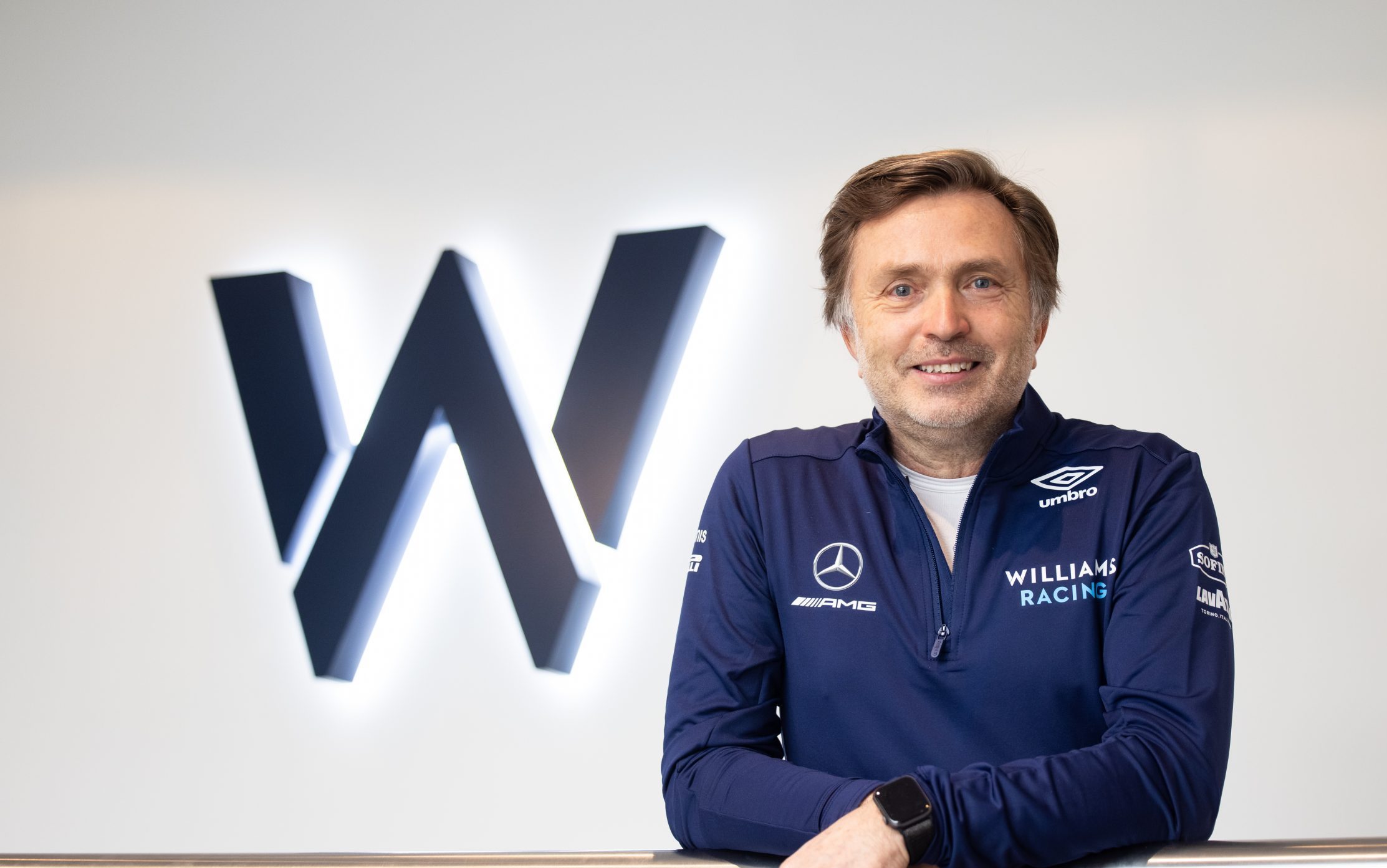
While he may be inexperienced in F1, the complex VW WRC operation gives him a good grounding, as does Rampf’s appointment as consultant. Both worked on the VW WRC programme, but some may recall Rampf was Sauber’s Technical for many years. The working relationship between the two will be beneficial as they know each other well and FX can be partly guided by Rampf’s experience in F1.
The FW43B
The task for designing the 2021 F1 car was made simpler or possibly more complex by a series of rules designed to react to the effect the pandemic had on team’s resources. Most of the car had to be carried over from 2020 with a new homologation process. By breaking the car up into sections and assemblies, the rules set out what could and couldn’t be changed over the winter.
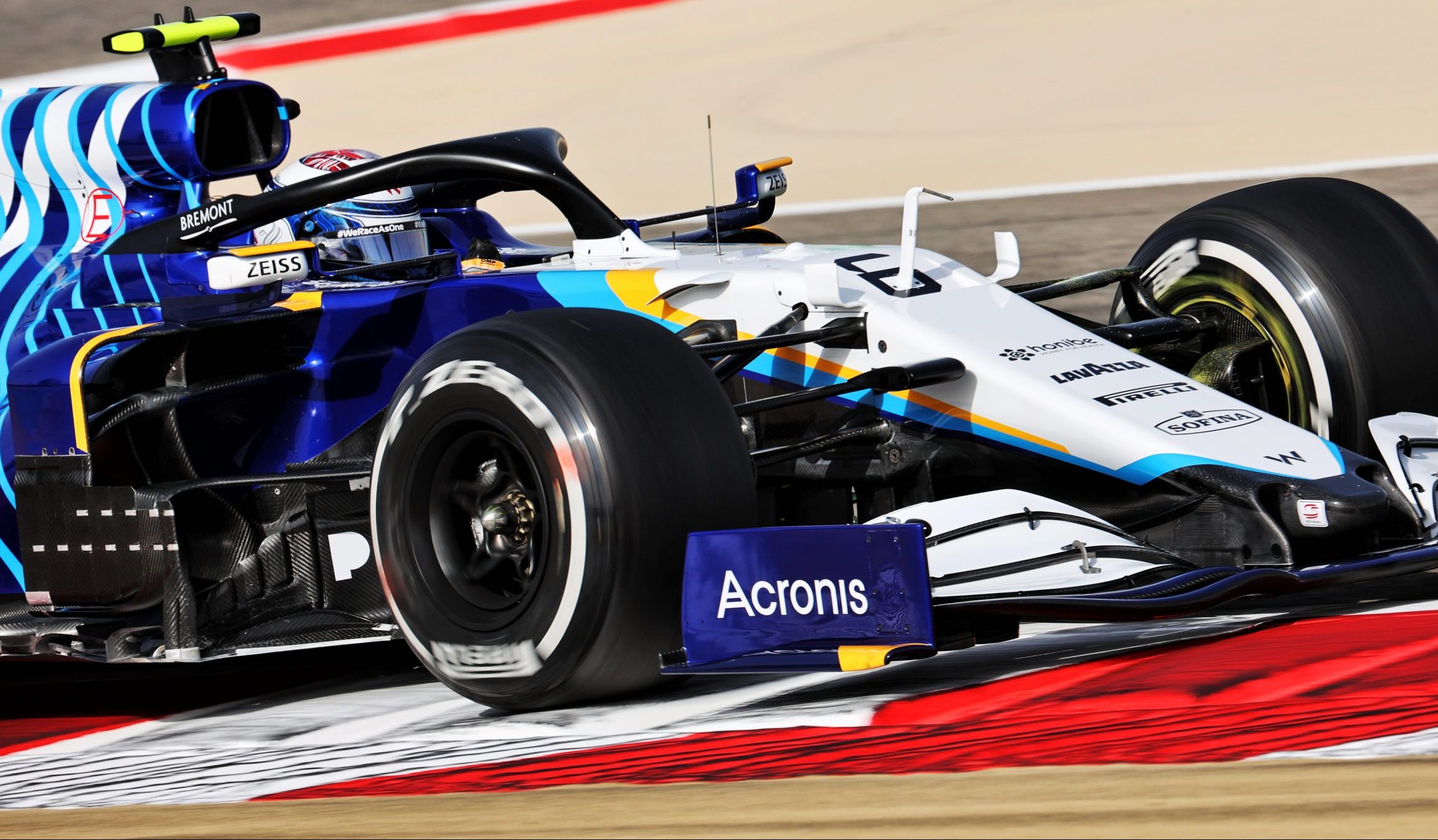
Only a small amount of under the skin changes were possible by using a development token system, each part of the car had a development ‘price’ of one or two tokens and the team only had two tokens to spend. Excluded from the process was the aerodynamic bodywork, cooling and the outer suspension. Additionally, the team had a fixed budget (based on the number of races) of $145m, as well as added restrictions on WindTunnel/CFD use. Compounding this, there were aero rule changes to the floor and diffuser to contend with.
Their starting point was the FW43, that struggled in performance terms compared to its rivals. The update to “B” specification was led by an aero redesign to increase downforce, even at the cost of some sensitivity to wind and traffic. There was also a light-weighting programme to get the car right on the limit. At the season’s start, Williams were quiet on their use of the development tokens available to them.
It transpires that the team had spent just one of the two available tokens during 2020, subsequently the remaining token went unused leaving Williams to focus its resources on 2021 aero development and the forthcoming 2022 car. To the team’s credit, the renders used to unveil the FW43B to the public were accurate when compared to the car that appeared in pre-season testing. Although the few days testing in Bahrain were just the start of the series of technical updates to the car which bring it to its current state of competitiveness.
Floor
The first key update was to overcome the biggest interseason rule changes around the floor. To slow the cars in a bid to decrease the ever-increasing loads on the Pirelli tyres, which were to be unchanged for 2021, the FIA reduced the complexity around the floor’s edge. When the FW43B first hit the track there was a simplistic floor treatment.
The floor was cut back from the midway point to just in front of the tyres as demanded by the new rules and the variety of slots and cuts were removed from the floor edge. Instead, the car run a small pair of fins ahead of the rear tyre while upstream the floor edge retained an upturned section with more fins directing airflow over it.
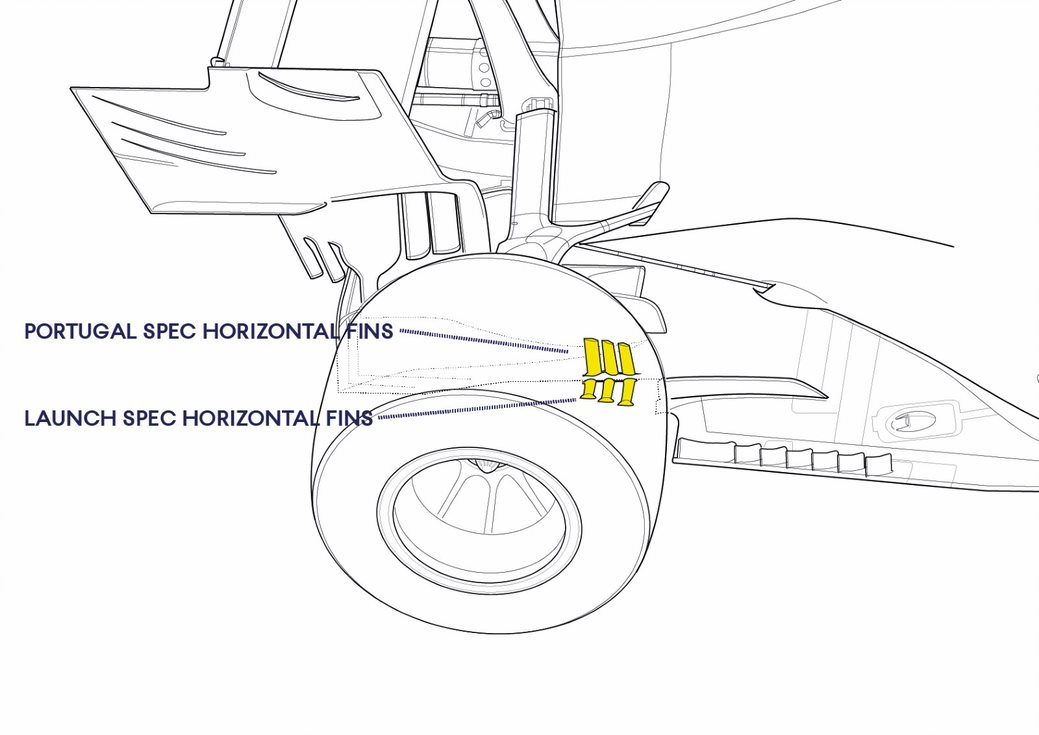
This was almost immediately changed to something closer to the solution that other teams had all converged upon. A distinct step was made in the floor edge profile, the demarks the different aero functions of the front and rear half of the floor. The front half retained the upwash treatment, used to create downforce under the front edge of the floor.
While the rear half is used to manage the outwash/inwash around the rear tyre, the midway step along with its three fins helped create a strong outwash to push the front tyre wake away from the rear of the car and around the outside of the rear tyre. Further down the floor three small upstanding fins further helped the outwash effect.
Another feature of the step in the floor profile was to do with the airflow passing between the tyre and diffuser. This area was much harder to manage without the slots of 2020 and the floor edge now tapering towards the tyre made matters worse as the air spilling off the top of the floor to underneath directed a vortex straight into the diffuser. By creating the step in the floor, the floor edge becomes more parallel to the car’s centreline and the resulting vortex was better directed into the tyre/diffuser gap, helping keep the diffuser running in undisturbed air.
Around the Baku GP further updates were introduced, the three upstanding fins being replaced with a tight row of six fins, to help create outwash around the rear tyre.
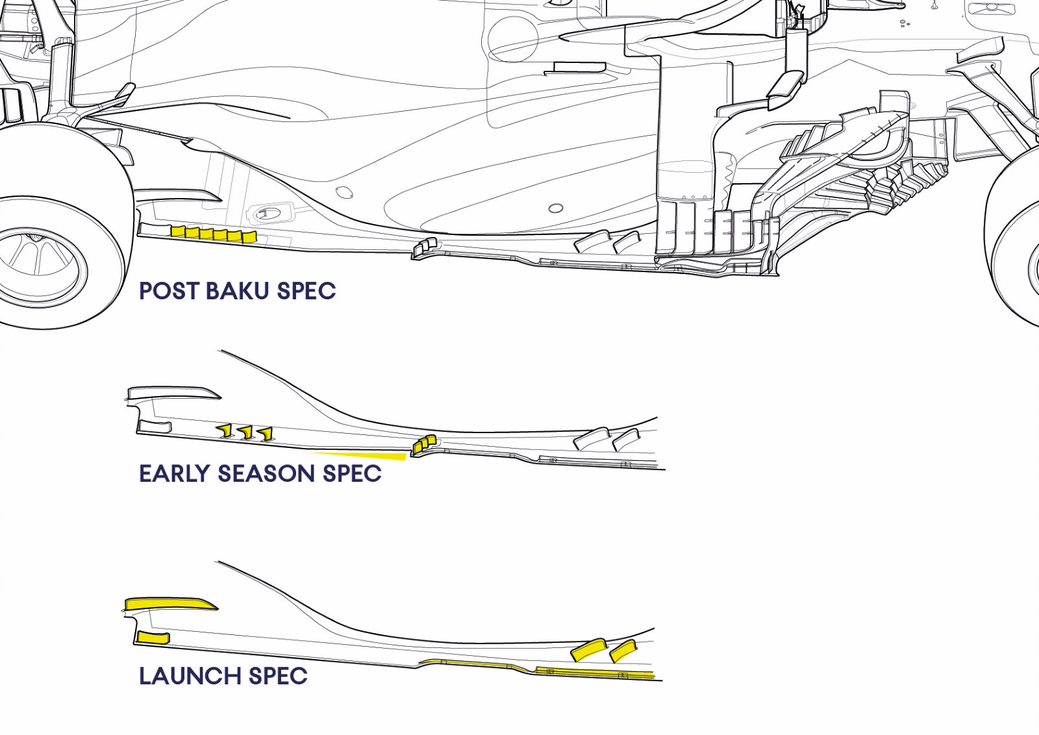
A detail noted at the car’s launch were a series of three horizontal fins jutting out from the floor in between the rear tyre and diffuser. This treatment was and remains unique to Williams and was raced in the first GPs of the season. At Imola a new treatment was introduced, flipping the concept 90-degrees. Now the fins stood vertically, this changed the direction of the vortices produced by the tip of each from vertical to lateral. This being just a refinement to the airflow passing through this critical area.
Brake Ducts
Another update around Imola was to the front brake ducts. While we apply the term ‘brake’ to this bodywork, only part of the complex bodywork inside the wheel is aimed at cooling the brake, a larger part of it is used to manage the general aerodynamics of the car. The inlet scoop that feeds the cooling air to the brakes and to the bypass ducts to blow out through the wheel was changed.
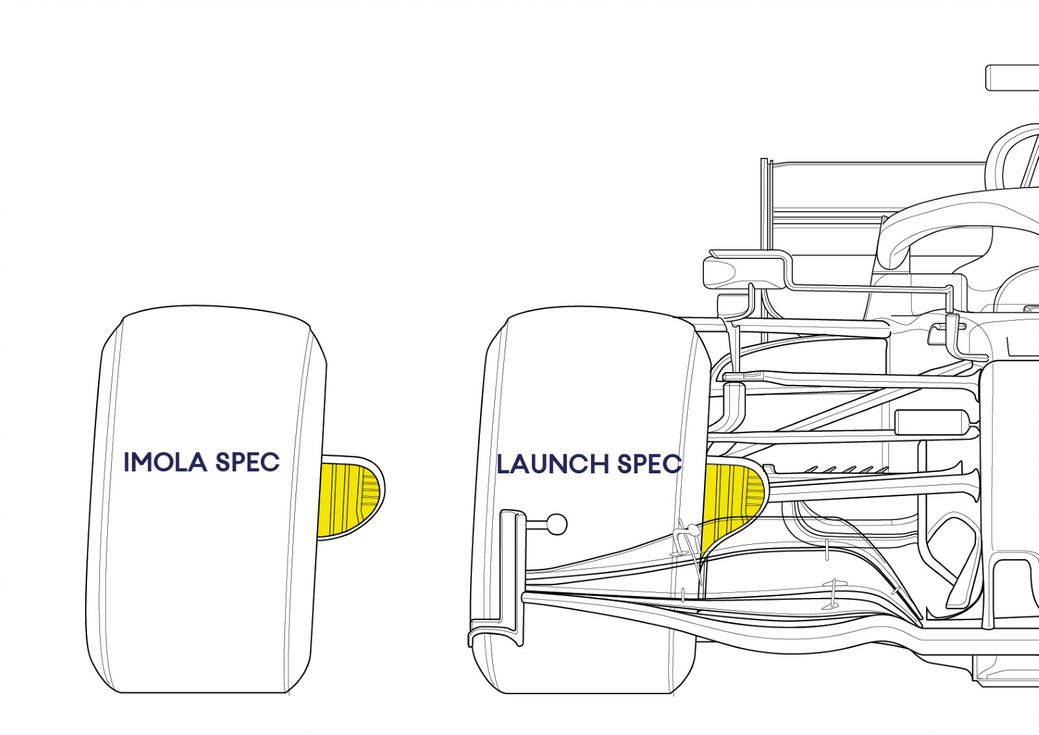
The launch specification scoop had the lower profile of the scoop blend tangentially into the rest of the brake drum, now the profile joined with a perpendicular joint. While this change may have altered the size of the scoop, the change was probably aimed at managing the airflow off the front wing and along the inner face of the wheel, rather than some tuning for brake cooling.
Bargeboards
Another part of the Baku update package was a revised bargeboard set up. Even at launch, the FW43B sported a complex package of aero surfaces around the side of the car. A large primary vane had a series of eleven fins along its footplate, each directing airflow under the car to help generate downforce at the front of the floor.
Three of those fins had a vertical vane attached to it to help create outwash. Along the top of the main bargeboard vane were three fins cut into its top edge. Spanning this assembly was a large ‘boomerang’ wing, directing airflow downwards.
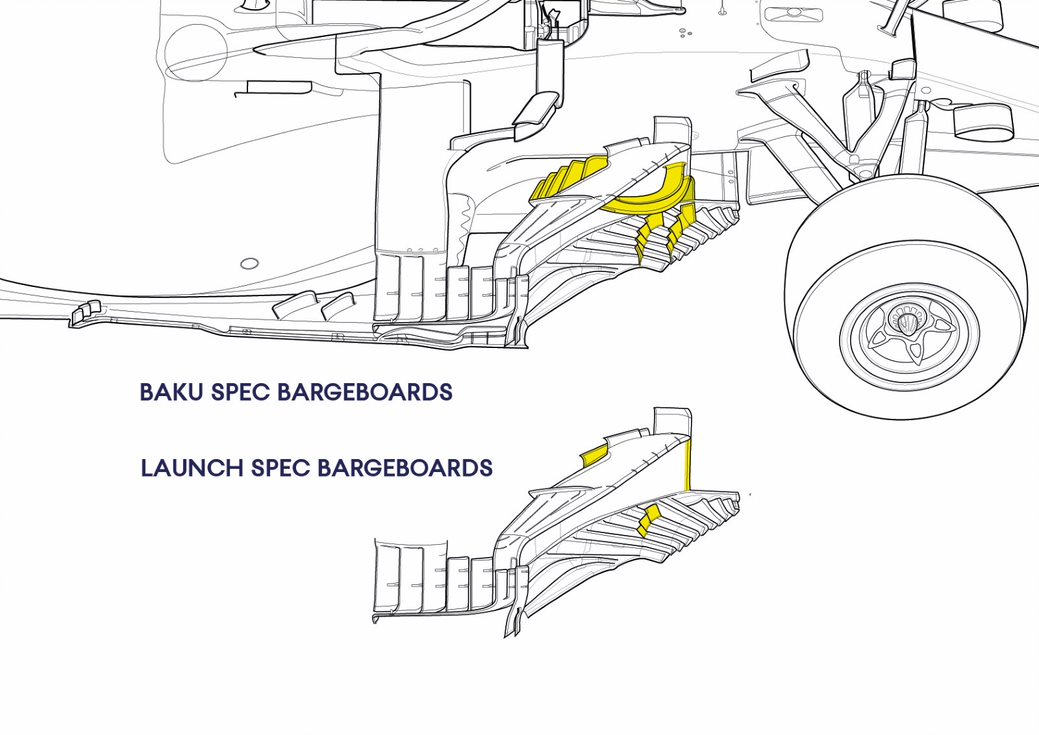
This basic assembly was augmented with added parts from Baku onwards. Firstly, the footplate gained more vertical fins with the set up now sporting two rows of five fins. Above these the boomerang wing gains a pair of “L” shaped fins to further guide airflow down and out of this area. Then, lastly, the top row of fins was replaced by a series of five fins cut out from the vanes top edge.
In summary, this change strengthened the bargeboards function of directing airflow under and around the car, creating more downforce directly and increasing the car’s aero efficiency by improving the airflow to the rear of the car, potentially allowing the rear wing angle to be reduced to cut drag along the straights (or vice versa having more downforce for no top speed penalty).
Season to Date
While its fair to say the car’s performance is not truly at a podium level, the FW43B has closed considerably on the midfield since 2020. Part of the key to the team’s success has been the added downforce, as qualifying proves there is pace in the car, this puts the team in a competitive position at the start of the race.
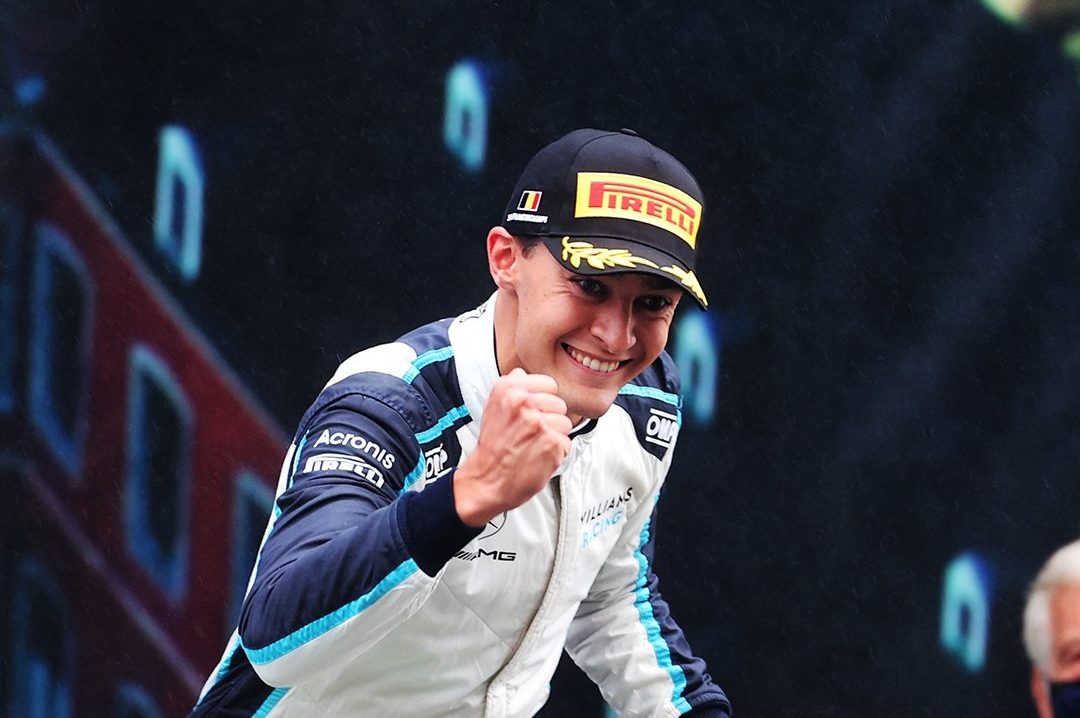
Race performance has been more difficult to judge, a tightly packed midfield and with aggressive rivals at race starts gives the team a difficult task. Perhaps the cars increased downforce but with greater sensitivity makes the car trickier in traffic? Up until the fast-flowing Red Bull Ring races, the car was just outside the top ten and therefore out of the points. Given the pack is led by Mercedes, Red Bull, Ferrari, McLaren and Alpine, all with great reliability, P12 is a more than reasonable finishing position in a pack of 20 cars.
Aiding their fight to gain more points finishes is Williams’s reliability. The team boasts just four DNFs with two resulting from crashes in the tricky wet Imola conditions, then two to mechanical reasons with a gearbox issue and an engine pneumatic valve issue retiring the car from the races.
As with most teams, the development of the car will have been run down at the Grove factory to allow more focus to be put on the 2022 car’s design. It’s unlikely we will any major developments added to the car, other than some specific aero changes for circuits such as Monza.
Now, the challenge will be to establish the team as a contender to the leading pack and separate itself from Haas and Alfa Romeo, something it’s probably already achieved numerically with the points garnered from Hungary and Spa.
Motorsport Technology is an Acronis initiative and Acronis are proud to be the official Cyber Protection Partner of Williams Racing. To find out more, please visit https://www.acronis.com/en-us/lp/msp-sports/

